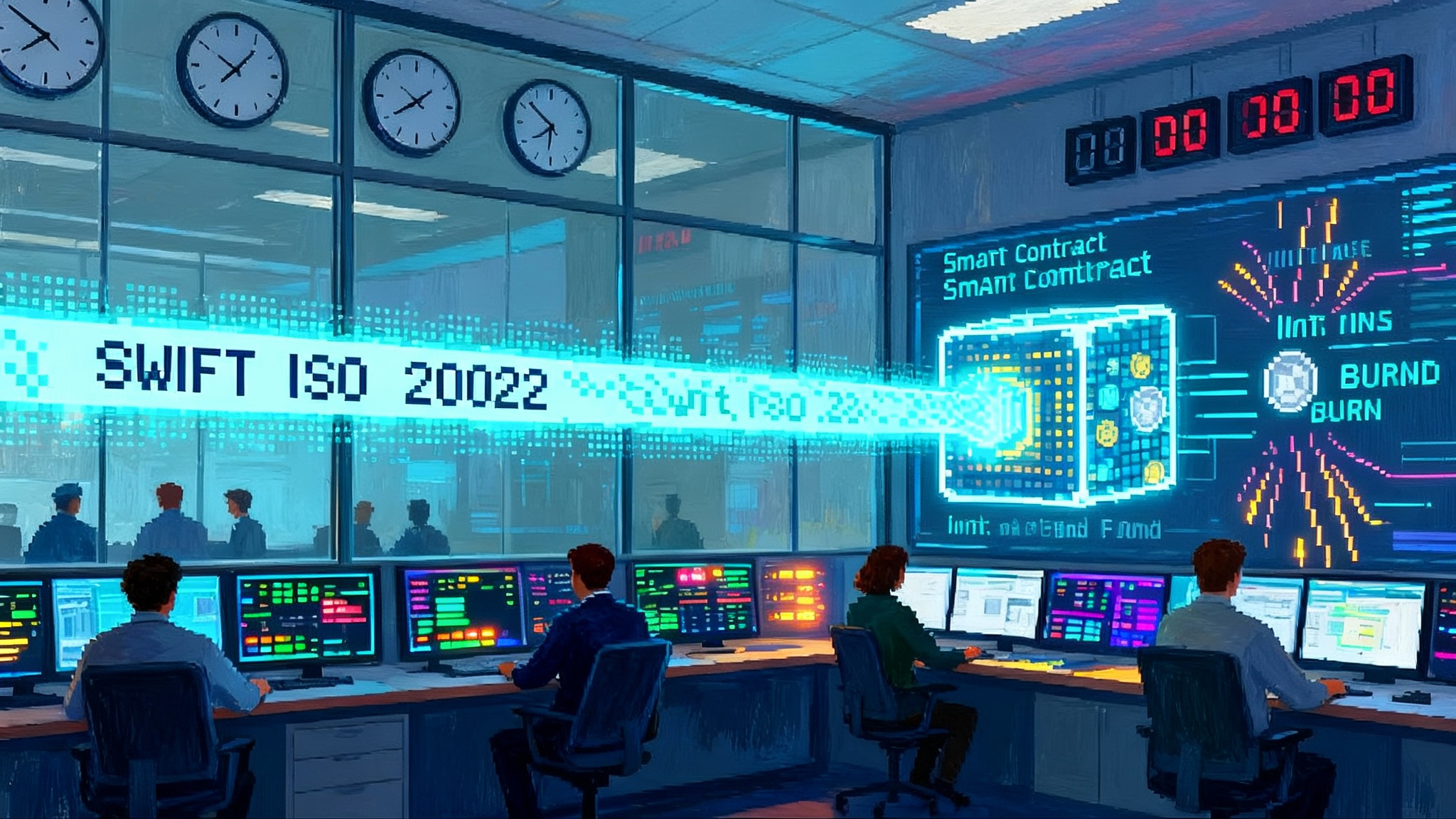America's Stablecoin Law: The 2026 Builder's Field Guide
The GENIUS Act is now law. This field guide shows builders exactly what changes in 2026: who can issue on-chain dollars, how rulemaking will unfold, what audits and disclosures will be required, and where the biggest product wins lie.

The breakthrough, and why 2026 is the year to move
On July 18, 2025 the United States enacted the Guiding and Establishing National Innovation for U.S. Stablecoins Act, better known as the GENIUS Act. The administration described it as the country’s first complete framework for payment stablecoins, including full‑reserve backing, monthly public reserve reporting, and anti‑money‑laundering controls. If you build or operate wallets, exchanges, fintech apps, or bank platforms, this is the signal that stablecoins are becoming a regulated payments rail in the United States. For a quick, authoritative overview of what became law, see the White House’s fact sheet on the GENIUS Act signing.
2026 is when the groundwork turns into rules, licenses, and market moves. Federal banking agencies and state supervisors have to stand up a new licensing regime, clarify examinations and reporting, and certify which state regimes are “substantial similarity.” If regulators finish their rulemakings within one year of enactment, the Act can become fully effective 120 days later, which points to a potential start in the final weeks of 2026. If rulemaking slips, the backstop effective date is January 18, 2027. In either case, 2026 is when teams decide charters, partners, reserves, disclosures, and chain strategy.
What follows is a builder’s playbook: what the statute says, the 2026 timeline, how banks, fintechs, and big‑tech wallets are likely to respond, and where the best product opportunities lie for compliant on‑chain dollars.
What the GENIUS Act actually requires
Think of the GENIUS Act as a narrow banking statute for payment stablecoins. It focuses on dollars meant for payments and settlement, not yield or speculation. The pillars:
- Who may issue: Only three categories may issue a payment stablecoin in the United States. One, a subsidiary of an insured depository institution that is approved by its primary federal or state banking regulator. Two, a federally qualified nonbank issuer supervised by the Office of the Comptroller of the Currency. Three, a state‑qualified issuer operating under a state regime that passes a federal “substantial similarity” certification.
- Federal or state path by size: Issuers under ten billion dollars in outstanding stablecoins can operate under certified state supervision. Crossing ten billion triggers a 360‑day transition to federal oversight or a pause on new issuance until the float drops below the threshold.
- Reserves: Issuers must maintain at least one dollar of permitted high‑quality liquid assets for every stablecoin in circulation. Permitted assets are conservative: cash, deposits at insured banks and credit unions, short‑dated Treasury bills, government money market funds, and certain Treasury‑secured repurchase agreements. Rehypothecation of reserves is prohibited.
- Disclosures and attestation: Issuers must publish a monthly public breakdown of reserve composition, provide clear redemption terms, and deliver executive certifications. Annual audits and ongoing examinations are part of supervision.
- Conduct rules: No consumer yield on stablecoins. No misleading names that imply government backing. Clear prohibitions against tying issuance to other purchases.
- Compliance and controls: Full Bank Secrecy Act and sanctions obligations, including customer identification programs and the technical capability to honor lawful orders to block, seize, or burn tokens.
- Bankruptcy protections: Reserves are ring‑fenced for holders, with priority rights over other creditors, plus a mechanism for swift relief from stays so redemptions can resume under court supervision.
- Foreign issuers: A foreign firm can serve U.S. customers only if its home regime is comparable, it registers with the federal regulator, and it meets the same technology and compliance obligations. Jurisdictions under comprehensive U.S. sanctions or designated primary money laundering concerns are excluded.
One sentence summary: U.S. law now treats payment stablecoin issuance as a licensed, segregated, fully reserved payments activity, with transparent reporting and bank‑grade compliance.
For the precise statutory language or to check definitions and deadlines, go to the enrolled text of S.1582 on Congress.gov: final text of the GENIUS Act.
The 2026 rulemaking and compliance calendar
You can plan 2026 around four clocks. Each one has a practical implication for product and go‑to‑market roadmaps.
-
180‑day agency reports by mid January 2026. Federal banking agencies and the Treasury Department owe Congress progress reports that describe their proposed regulatory approaches. Expect previews of chartering checklists, examination focus areas, and early guidance on audits and reserve disclosures. Action: watch for comment dockets to open quickly after those reports.
-
One‑year rulemaking target by July 18, 2026. Primary federal regulators, the Secretary of the Treasury, and state stablecoin regulators are directed to promulgate implementing rules within one year of enactment. These include applications and supervisory manuals for federally qualified nonbank issuers, templates for state “substantial similarity” certification, and standards for custody segregation and disclosure.
-
Potential effective date in late 2026. If final rules are issued around July 2026, the statute can become effective 120 days later. That points to a November 2026 in‑force date for issuers. If rules slip, everything still goes live by January 18, 2027. Either way, digital asset service providers have a separate three‑year transition that culminates on July 18, 2028, when platforms will be able to list only GENIUS‑compliant payment stablecoins.
-
State certification window during 2026. States seeking to supervise sub‑ten‑billion issuers must submit their substantially similar regimes for certification within a year of enactment. Expect early movers like New York to publish updates to existing frameworks and pursue expedited federal review.
Practical takeaway: 2026 is the last year to decide your path, submit a complete application, and build the technology and compliance stack that satisfies your selected supervisor.
How major players are likely to move
-
Banks and credit unions: Expect large institutions to run two experiments in parallel. One track will be tokenized deposits for on‑us transfers, intraday liquidity, and wholesale settlement. The other will be fully reserved payment stablecoins for retail and merchant settlement. Issuing as a bank subsidiary lets firms leverage existing compliance and audit teams, while a nonbank OCC charter could offer faster iteration under a purpose‑built framework. Watch for bank‑fintech partnerships that mirror existing prepaid and card program manager models.
-
Fintech issuers: Circle, Paxos, and other pure‑play stablecoin firms will likely pursue the federally qualified nonbank path, with contingency plans to operate under certified states until their federal licenses are granted. The no‑yield rule pushes these firms to monetize via float management at Treasury bill rates, enterprise APIs, and payments acquiring services rather than interest paid to consumers.
-
Exchanges and brokers: Coinbase, Kraken, Robinhood, and others must prepare for the platform transition that culminates in 2028. The earlier they align listings and custody to GENIUS‑compliant issuers, the smoother the transition. Expect early delisting or geofencing for noncompliant foreign stablecoins if those issuers cannot meet comparability and registration requirements.
-
Big‑tech wallets: Because the Act generally restricts non‑financial public companies from issuing stablecoins absent unanimous approval from a federal interagency committee, Apple Pay, Google Pay, and merchant platforms like Amazon and Shopify are most likely to partner with licensed issuers rather than seek their own charters. For how wallets become distribution layers, see Telegram's TON superapp moment.
-
Global issuers: Tether and other non‑U.S. firms face a binary choice. Either register and meet comparability and technical controls or lose broad U.S. platform access by mid 2028. That decision will reshape volumes across chains where U.S. customers are meaningful.
The competitive landscape: models, reserves, audits, and disclosures
Issuers will differentiate on three axes that are legible to regulators and customers alike.
1) Charter and supervision model
- Bank subsidiary: Pros include established risk, compliance, and audit programs, plus potential access to central bank services through the parent. Cons include heavier consolidated supervision and product change control. Best fit for banks with strong treasury, corporate payments, and merchant relationships.
- Federally qualified nonbank: Pros include a clean‑room entity with a clear, bespoke supervisory manual. Cons include building second‑line functions from scratch and obtaining a new charter with on‑site exams and readiness reviews. Best fit for focused issuers with deep crypto infrastructure expertise.
- Certified state regime: Pros include speed to market for sub‑ten‑billion issuance and lower cost. Cons include uncertainty over federal certification and a forced migration if growth exceeds the threshold. Best fit for regional or niche programs and for pilots tied to specific corridors or platforms.
2) Reserve construction and custody
- The baseline: only permitted assets, segregated from the issuer’s own funds, with no rehypothecation. Most issuers will converge on short‑dated Treasuries plus insured deposits for intraday liquidity.
- Differentiators: number and quality of custodians, direct rather than indirect Treasury exposure, and continuous disclosure beyond the minimum monthly level. Expect some issuers to publish daily dashboards, with attestation feeds piped directly from custodians and brokers.
3) Assurance and disclosure
- Monthly public reserve composition reports are the floor. Annual audits and ongoing exam workpapers are a given. Expect issuers to compete on near‑real‑time reporting, executive certifications, and independent third‑party attestations of smart‑contract controls. The issuers that turn transparency into a product will win institutional trust.
The opportunity surface for compliant on‑chain dollars
-
Merchant settlement at internet speed: Stablecoin acceptance at the point of sale and in ecommerce can lower acceptance costs and compress settlement times from days to minutes. A credible pitch is 24x7 settlement, immediate finality on supported chains, and chargeback‑free push payments combined with consumer protections in wallet software.
-
Cross‑border remittances and B2B corridors: A dollar that is fully reserved, easy to redeem, and regulator‑blessed will be attractive to remittance processors and marketplaces. Early corridors will be where counterparties can hold or convert dollars without friction. Compliance advantage: embedded sanctions checks and travel rule messaging built into wallet‑to‑wallet flows.
-
On‑chain treasury and marketplaces: Corporates, prop trading firms, and funds will hold more operational balances in compliant stablecoins, especially for settlement across tokenized securities and repo platforms. Expect interoperable escrow primitives and programmable settlement windows to emerge as standard features.
-
Programmable payroll and benefits: Contractors and creators will opt into same‑day payouts with automatic tax withholding logic and off‑ramps to bank accounts. Human resources and payroll vendors can offer instant earned wage access without credit risk because balances are pre‑funded in dollars.
-
DeFi that enterprises can actually use: A compliant base layer unlocks permissioned pools where counterparties are known and reserves are fully segregated. The winning designs will make composability safe by enforcing allow‑lists and circuit breakers at the token or pool level.
A 2026 builder’s checklist
Use this to anchor your roadmap and board updates.
- Choose your charter path
- Decide whether you will be a bank subsidiary, a federally qualified nonbank, or a state‑qualified issuer. Align your capital plan, governance, and executive team backgrounds to suit the supervisor you choose. Draft the application and schedule pre‑filing meetings in the first half of 2026.
- Design reserves and custody
- Lock a written investment policy that mirrors permitted assets. Select at least two independent custodians and one cash management bank. Implement segregation at the account and ledger layer. Build a daily reconciliation engine that produces both internal dashboards and public summaries.
- Build the disclosure and assurance engine
- Implement automated reserve composition reporting that can publish monthly snapshots without manual work. Engage an audit firm early for integrated audits that include information technology general controls and smart‑contract reviews. Draft your redemption policy and customer disclosures in plain language.
- Engineer compliance into the token and wallet
- Integrate sanctions screening, travel rule messaging, and suspicious activity monitoring at the wallet and service layer. Implement the technical capability to comply with lawful orders to freeze, seize, burn, or prevent transfers, with auditable administrator actions and dual‑control approvals. UX matters here too; passkeys make smart wallets default and can reduce KYC friction when combined with risk scoring.
- Pick chains and design for portability
- Support at least one high‑throughput chain with predictable fees and robust indexing. Abstract chain risk by issuing on multiple chains with a canonical reserve register and a migration path if a chain degrades. If your distribution is multichain, remember that AggLayer resets multichain liquidity, which affects treasury routing and bridge risk.
- Prepare for naming, marketing, and customer protection rules
- Avoid names that imply government backing. State prominently that the token is not insured by any federal agency. Offer dispute support and refund workflows at the wallet level to compete with card‑like customer expectations without violating the no‑chargeback model of push payments.
- Stand up a redemption and liquidity plan
- Ensure retail and institutional holders can redeem quickly at par. Maintain bank rails and market maker relationships to convert Treasuries to cash rapidly during stress. Run tabletop exercises on large redemptions and custodian outages.
- Establish governance and incident response
- Charter a risk committee, record executive certifications, and create a transparent incident log for smart‑contract bugs, key rotations, and regulatory actions. Publish a data retention and privacy policy aligned with your chosen supervisor.
How banks, fintechs, and big tech will compete in practice
-
Banks will own enterprise flows. Their edge is trusted onboarding, treasury relationships, and balance sheet access for instant redemption. Expect them to prioritize tokenized corporate payments and settlement for marketplaces.
-
Fintech issuers will own developer experience. Their edge is APIs, composability, and multi‑chain distribution. Expect them to move first on ecommerce plugins, programmatic payroll, and wallet SDKs that make travel rule messaging invisible to developers.
-
Big‑tech wallets will unlock distribution. They will not need to issue. Partnering with licensed issuers lets them light up compliant dollars inside the interfaces consumers already use, from checkout to peer‑to‑peer. For the broader platform playbook, revisit Telegram's TON superapp moment.
Result: by the end of 2026 you should expect at least two federally qualified nonbank issuers in market, several state‑qualified pilots below ten billion, and bank subsidiaries piloting with corporate clients. The consumer experience will start to look consistent across major wallets because the rules force common disclosures and redemption service levels.
Metrics that matter in 2026
- Reserve transparency: time to publication for the monthly report, and how much detail you provide beyond the minimum.
- Redemption performance: median and tail times for redemption requests in normal and stressed conditions.
- Compliance precision: false positive rate in sanctions and suspicious activity monitoring, and evidence that you act on quality alerts.
- Developer adoption: number of applications using your APIs and the average time to first successful payment.
- Merchant economics: effective cost per transaction vs card rails, including fraud losses and refunds.
Risks to price in
- Rulemaking friction: Agencies could stagger their rules, leading to temporary mismatches between federal and state expectations. Mitigation: design to the strictest plausible interpretation so you do not rebuild twice.
- Foreign issuer uncertainty: If comparability determinations drag on, platforms may preemptively restrict non‑registered foreign stablecoins. Mitigation: publish a migration guide for users holding noncompliant tokens.
- Chain‑level events: Congestion, forks, or governance incidents can disrupt redemptions. Mitigation: issue on multiple chains and maintain canonical supply controls off‑chain with instant suspend and migrate tools.
The bottom line for builders
In 2026, clarity replaces guesswork. The GENIUS Act sets who can issue, what backs every token, who watches the watchers, and how customers are protected. Your decisions this year determine whether you are live with a licensed stablecoin when the rules switch on. Choose your charter. Architect your reserves and custody. Build disclosure and compliance into the product. Integrate with the wallets and merchants that already have distribution. If you do those things well, your on‑chain dollar will feel like money, not a science project.
The new framework is simple in spirit. Treat a payment stablecoin like a digital cashier’s check with perfect collateral and clear rights. Do that transparently and at internet speed, and 2026 will not just be another year of crypto headlines. It will be the year that U.S. dollars on public chains start to behave like a national payments rail, with your product riding on top.








